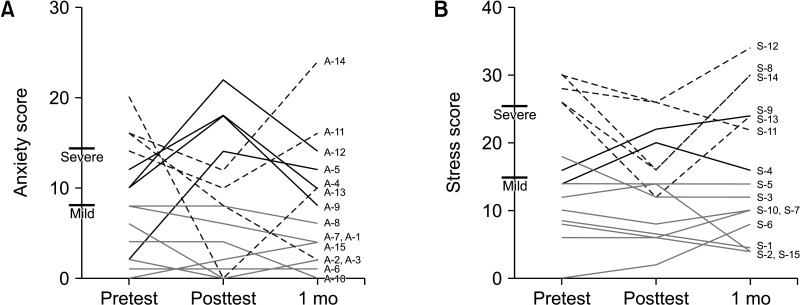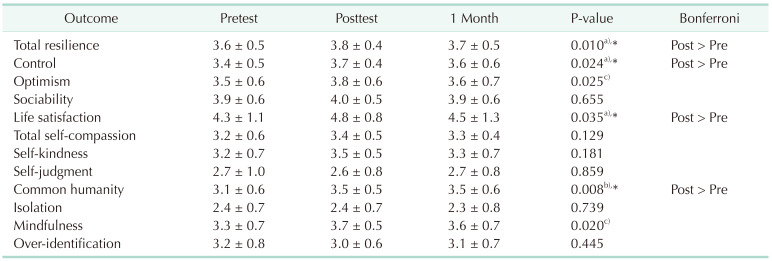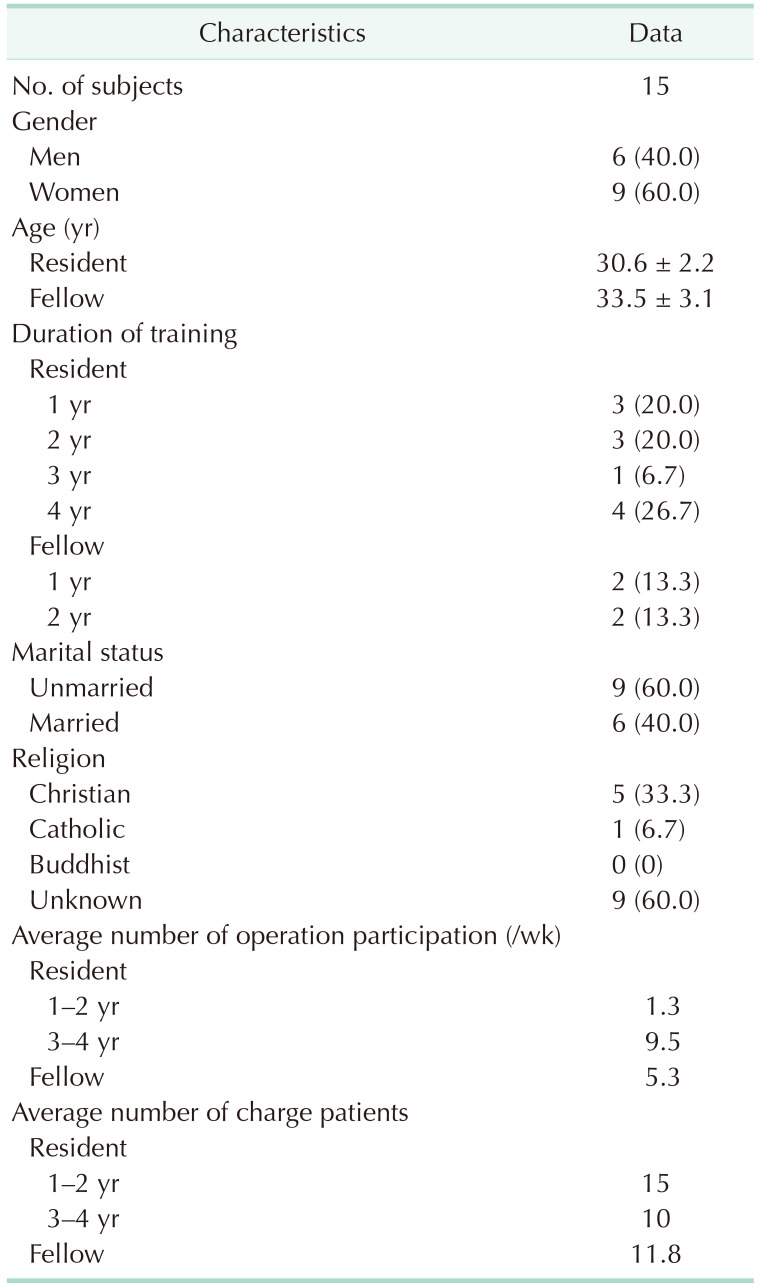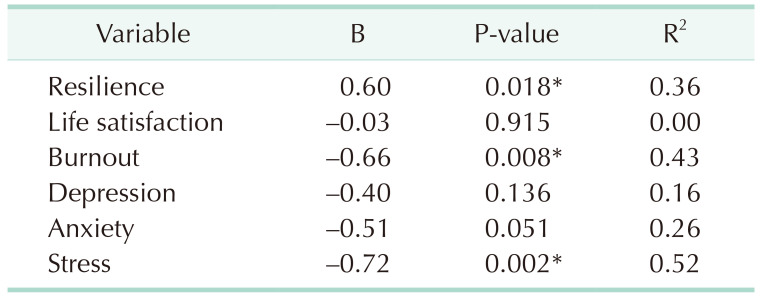1. Shanafelt TD, Boone S, Tan L, Dyrbye LN, Sotile W, Satele D, et al. Burnout and satisfaction with work-life balance among US physicians relative to the general US population. Arch Intern Med. 2012; 172:1377–1385. PMID:
22911330.
2. Elmore LC, Jeffe DB, Jin L, Awad MM, Turnbull IR. National survey of burnout among US general surgery residents. J Am Coll Surg. 2016; 223:440–451. PMID:
27238875.
3. Shin S. The relationship between burnout and the personality characters among interns. Dongguk J Med. 2009; 16:185–192.
4. Dimou FM, Eckelbarger D, Riall TS. Surgeon burnout: a systematic review. J Am Coll Surg. 2016; 222:1230–1239. PMID:
27106639.
5. Lebares CC, Guvva EV, Ascher NL, O’Sullivan PS, Harris HW, Epel ES. Burnout and stress among us surgery residents: psychological distress and resilience. J Am Coll Surg. 2018; 226:80–90. PMID:
29107117.
7. Freund Y. The challenge of emergency medicine facing the COVID-19 outbreak. Eur J Emerg Med. 2020; 27:155. PMID:
32205709.
8. de Wit K, Mercuri M, Wallner C, Clayton N, Archambault P, Ritchie K, et al. Canadian emergency physician psychological distress and burnout during the first 10 weeks of COVID-19: a mixed-methods study. J Am Coll Emerg Physicians Open. 2020; 1:1030–1038. PMID:
32905025.
9. Sotile WM, Fallon R, Orlando J. Curbing burnout hysteria with self-compassion: a key to physician resilience. J Pediatr Orthop. 2020; 40 Suppl 1:S8–S12. PMID:
32502063.
10. Smith BW, Dalen J, Wiggins K, Tooley E, Christopher P, Bernard J. The brief resilience scale: assessing the ability to bounce back. Int J Behav Med. 2008; 15:194–200. PMID:
18696313.
11. Lebares CC, Hershberger AO, Guvva EV, Desai A, Mitchell J, Shen W, et al. Feasibility of formal mindfulness-based stress-resilience training among surgery interns: a randomized clinical trial. JAMA Surg. 2018; 153:e182734. PMID:
30167655.
12. Song Y, Swendiman RA, Shannon AB, Torres-Landa S, Khan FN, Williams NN, et al. Can we coach resilience? An evaluation of professional resilience coaching as a well-being initiative for surgical interns. J Surg Educ. 2020; 77:1481–1489. PMID:
32446771.
13. Neff KD, Knox MC, Long P, Gregory K. Caring for others without losing yourself: an adaptation of the Mindful Self-Compassion Program for Healthcare Communities. J Clin Psychol. 2020; 76:1543–1562. PMID:
32627192.
14. Neff KD, Germer C. Self-compassion and psychological well-being. Seppälä EM, Simon-Thomas E, Brown SL, Worline MC, Cameron CD, Doty JR, editors. The Oxford handbook of compassion science. Oxford University Press;2017. p. 371–385.
15. Olson K, Kemper KJ. Factors associated with well-being and confidence in providing compassionate care. J Evid Based Complementary Altern Med. 2014; 19:292–296. PMID:
24986815.
16. Babenko O, Mosewich AD, Lee A, Koppula S. Association of physicians' self-compassion with work engagement, exhaustion, and professional life satisfaction. Med Sci (Basel). 2019; 7:29. PMID:
30759845.
17. Bluth K, Lathren C, Silbersack Hickey JV, Zimmerman S, Wretman CJ, Sloane PD. Self-compassion training for certified nurse assistants in nursing homes. J Am Geriatr Soc. 2021; 69:1896–1905. PMID:
33837539.
18. Maslach C, Jackson SE. Maslach burnout inventory: manual. 2nd ed. Consulting Psychologists Press;1986.
19. Neff KD. The development and validation of a scale to measure self-compassion. Self Identity. 2003; 2:223–250.
20. Diener E, Emmons RA, Larsen RJ, Griffin S. The satisfaction with life scale. J Pers Assess. 1985; 49:71–75. PMID:
16367493.
21. Henry JD, Crawford JR. The short-form version of the Depression Anxiety Stress Scales (DASS-21): construct validity and normative data in a large non-clinical sample. Br J Clin Psychol. 2005; 44(Pt 2):227–239. PMID:
16004657.
22. Shin WY, Kim MG, Kim JH. Developing measures of resilience for Korean adolescents and testing cross, convergent, and discriminant validity. Stud Korean Youth. 2009; 20:105–131.
23. Lyubomirsky S, Sheldon KM, Schkade D. Pursuing happiness: the architecture of sustainable change. Rev Gen Psychol. 2005; 9:111–131.
24. Golembiewski RT, Munzenrider RF, Stevenson JG. Phases of burnout: developments in concepts and applications. Praeger;1988.
25. Shin H, Noh H, Jang Y, Park YM, Lee SM. A longitudinal examination of the relationship between teacher burnout and depression. J Employ Couns. 2013; 50:124–137.
26. Gilbert P. Compassion: conceptualizations, research and use in psychotherapy. Routledge;2005.
27. Galaiya R, Kinross J, Arulampalam T. Factors associated with burnout syndrome in surgeons: a systematic review. Ann R Coll Surg Engl. 2020; 102:401–407. PMID:
32326734.
28. Dyrbye LN, West CP, Satele D, Boone S, Tan L, Sloan J, et al. Burnout among U.S. medical students, residents, and early career physicians relative to the general U.S. population. Acad Med. 2014; 89:443–451. PMID:
24448053.
29. Goldhagen BE, Kingsolver K, Stinnett SS, Rosdahl JA. Stress and burnout in residents: impact of mindfulness-based resilience training. Adv Med Educ Pract. 2015; 6:525–532. PMID:
26347361.
30. Mistretta EG, Davis MC, Temkit M, Lorenz C, Darby B, Stonnington CM. Resilience training for work-related stress among health care workers: results of a randomized clinical trial comparing in-person and smartphone-delivered interventions. J Occup Environ Med. 2018; 60:559–568. PMID:
29370014.







 PDF
PDF Citation
Citation Print
Print






 XML Download
XML Download